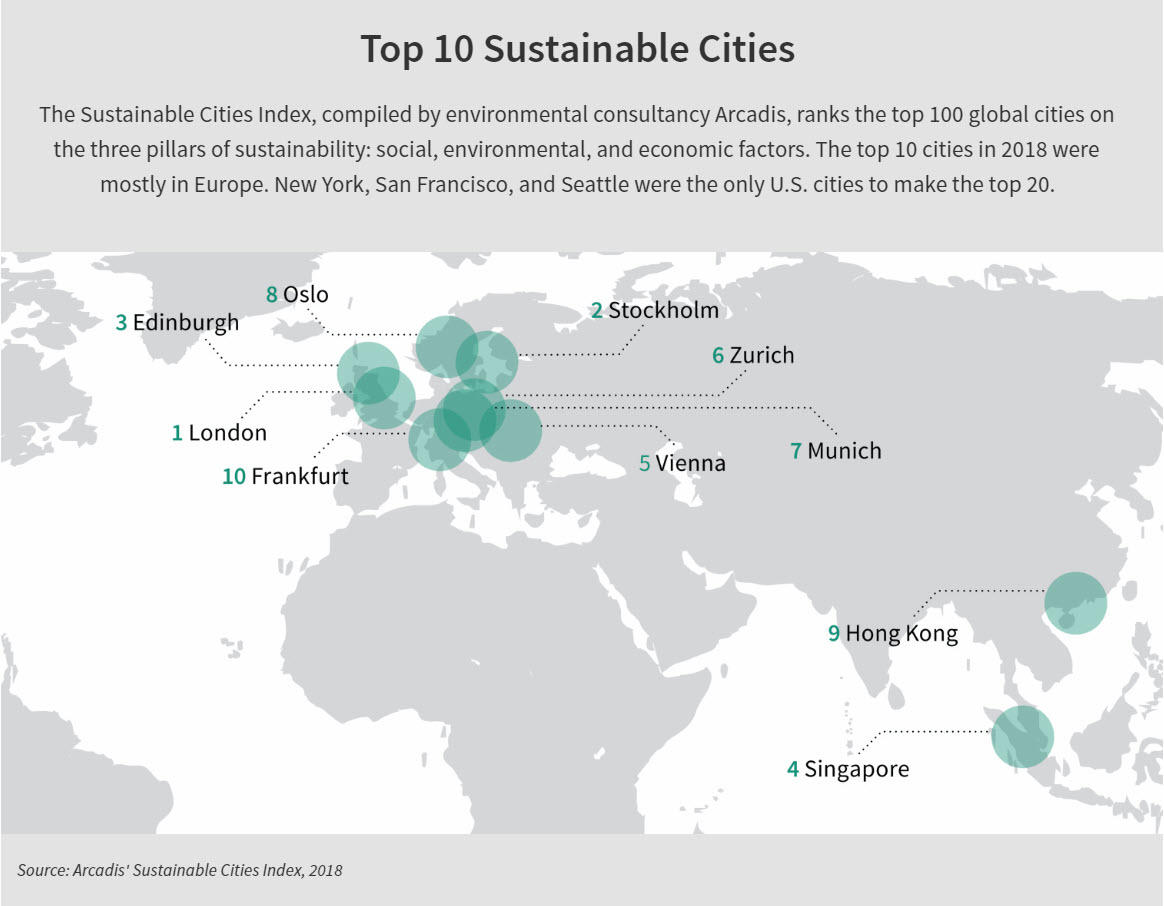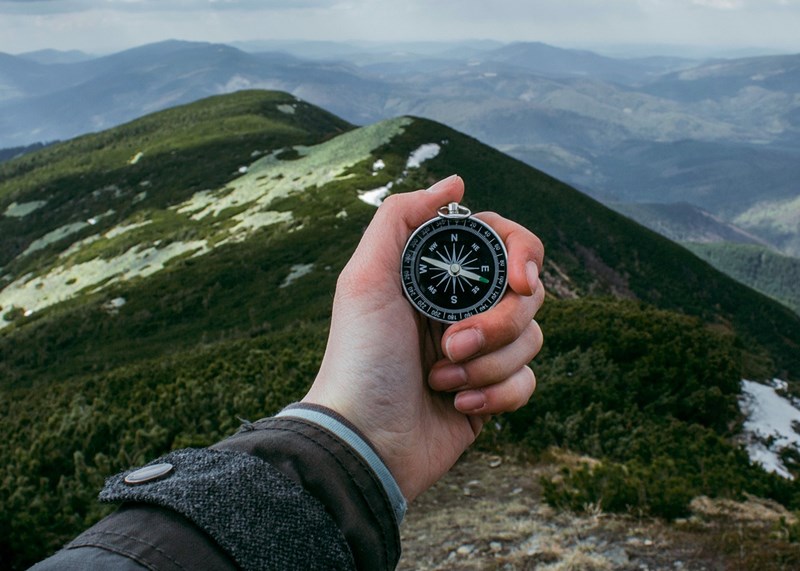More than half the world's population now lives in urban areas. By 2050 that number is projected to swell to two-thirds, or 6.5 billion people, according to United Nations projections. Today's three biggest cities—Tokyo, New Delhi, and Shanghai—all have populations well above 20 million. Daily headlines often contain stories of polluted, congested, and resource-stressed mega-cities struggling to cope.
The stress has put pressure on governments and urban planners, not just residents. While cities occupy only 3% of the Earth's land they account for up to 80% of energy consumption and at least 70% of carbon emissions. Commercial real estate, as one of the largest users of energy, is right in the center of plans to cope. One major trend that has emerged in recent years is a push to create "green" buildings—and, eventually, "green" cities.

The push is recognizing the benefits of adopting sustainable business practices to not only increase energy efficiency and reduce environmental impact but also to create a sense of community, especially around improving health and well-being.
"You're seeing a very different approach to design, construction, and engineering—for lofts, offices, apartments, schools, public buildings—that is much more people friendly and environmentally sustainable," says Brandon Dobell, a managing director with William Blair's Investment Banking team.
"These trends are likely to continue because of their qualitative and quantitative benefits to individuals, companies, organizations, and society as a whole," adds Dobell, who specializes in the real estate technology and services sector.
Going green
A green building is broadly defined as a building that, in its design, construction or operation, reduces or eliminates negative impacts, and can create positive impacts, on our climate and natural environment.
The World Green Building Council specifies numerous features that can make a building "green":
- Efficient use of energy, water, and other resources
- Use of renewable energy, such as solar energy
- Pollution and waste reduction measures, and the enabling of re-use and recycling
- Good indoor environmental air quality
- Use of materials that are nontoxic, ethical, and sustainable
- Consideration of the environment in design, construction, and operation
- Consideration of the quality of life of occupants in design, construction, and operation
- A design that enables adaptation to a changing environment
Business Benefits Expected from Green Building Investments
In the United States and Europe, green building guidelines have filtered in to almost all parts of the construction process—from use of ecofriendly materials like bamboo, recycled wood, and metal, to applying solar and other alternative energies, to creating more efficient heating and cooling (HVAC) systems, to designing more energy- and water-saving structures with a lower carbon footprint.
Within this wave of ecofriendly thinking has been woven in ideas of more open floor plans, natural light, communal spaces, and other common amenities so that workers and residents can better meet, communicate, and socialize.
"A primary focus today in real estate is the recognition of a direct connection between using less energy or using it better and making money," Dobell says. "You can make three changes to your energy use and save $100,000 a day in energy costs. That's why real estate technology and services companies are spending an awful lot of time to help businesses to do just that."
In the United States certified green construction grew an estimated 15% year-over-year from 2015 to 2018, with annual spending reaching $224.4 billion by 2018, according to the U.S. Green Building Council.
Product innovation, M&A activity rise
The Urban Land Institute, a nonprofit focused on responsible land use and sustainability worldwide, hosted a panel of real estate experts at its spring meeting in Nashville. One topic of discussion: New software that monitors buildings' energy and water use may be a game-changer for the industry.
The panel cited the example of a New York real estate company that is saving $5 million a year in energy costs by automatically lowering its air-conditioning systems when there are fewer people in the building then readjusting it when employees return.
Such reawakened consciousness of energy use patterns is all part of the green building trend. So it's no surprise that venture capital is finding its way to tech start-ups focused on green initiatives. Big real estate companies like CBRE, Cushman & Wakefield, JLL, Colliers, and others are also investing in solutions to increase their building efficiencies and expanding their services.
Everything we’re doing has a technology angle to it and some sort of resource conservation component.
ANDY MILLER, William Blair Investment Banker
At William Blair, there's been a pickup in M&A activity in this space.
"There is so much energy consumption that takes place in buildings that it's an increasing focus for our clients," says William Blair investment banker Andy Miller, who leads the commercial services team.
Among the offerings the team is currently working on are businesses that specialize in HVAC and refrigeration efficiency, solar panel installations, waste hauling, and environmental consulting.
"There is a big trend in this space. Everything we're doing has a technology angle to it and some sort of resource conservation component," Miller says. "They all share similar values around being more efficient and more effective as a society with what we produce and consume."
Worldwide growth
If green building principles are sweeping American construction and planning circles, the same is true overseas. Many European countries remain far ahead of the United States. Huge markets like China, India, and the arid Middle East are also embracing the concept. China's five-year plan calls for 50% of all new urban buildings to be certified green by 2020. India's choking air pollution by New Delhi and Bangalore is raising pressure on authorities to demonstrate solutions. Dubai last year completed a 5 million square-foot sustainability city featuring 500 villas with rooftop solar panels and car-free zones.
Most Famous LEED Buildings
The U.S. Green Building Council runs one of the best-known certification sustainability programs for buildings, which debuted in the 1990s through its Leadership in Energy and Environmental Design (LEED) program.
The program rates the sustainability of buildings based on energy and water efficiency, indoor air quality, access to transportation, and other sustainable factors. The more points, the higher the LEED rating. Today, more than 100,000 commercial properties globally are LEED certified.
Some of the most famous LEED buildings or structures are Chicago Bears Soldier Field, Salt Lake City Library, China's Shanghai Tower, Facebook Headquarters in California, Two International Tower in Hong Kong, and the list goes on.
Additionally, William Blair's new corporate headquarters in Chicago is LEED Gold certified, a top rating, scoring high on sustainable site, indoor environmental quality, water reduction, and innovation.


